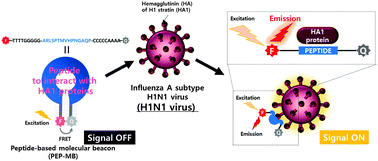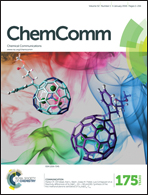Simple, rapid detection of influenza A (H1N1) viruses using a highly sensitive peptide-based molecular beacon†
Abstract
A peptide-based molecular beacon (PEP-MB) was prepared for the simple, rapid, and specific detection of H1N1 viruses using a fluorescence resonance energy transfer (FRET) system. The PEP-MB exhibited minimal fluorescence in its “closed” hairpin structure. However, in the presence of H1N1 viruses, the specific recognition of the hemagglutinin (HA) protein of H1 strains by the PEP-MB causes the beacon to assume an “open” structure that emits strong fluorescence. The PEP-MB could detect H1N1 viruses within 15 min or even 5 min and can exhibit strong fluorescence even at low viral concentrations, with a detection limit of 4 copies.


 Please wait while we load your content...
Please wait while we load your content...